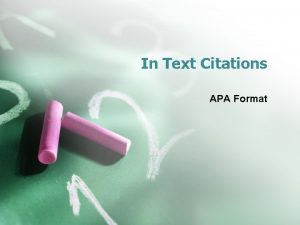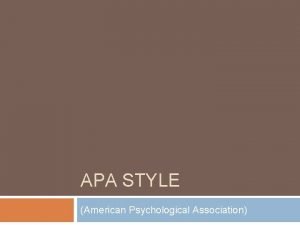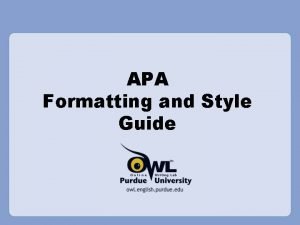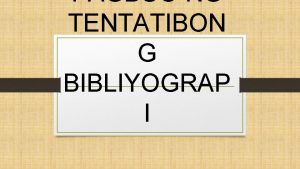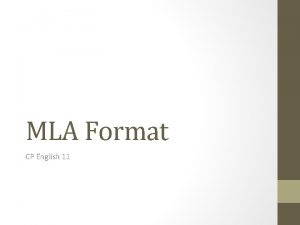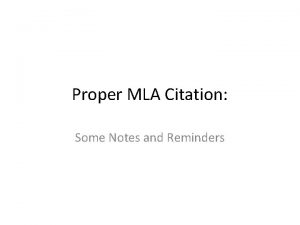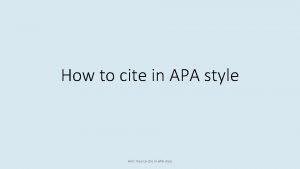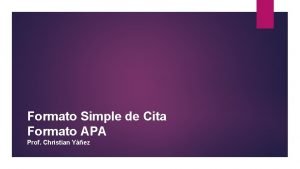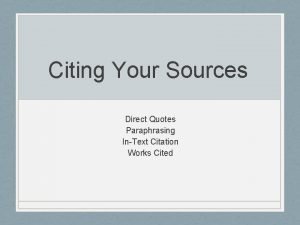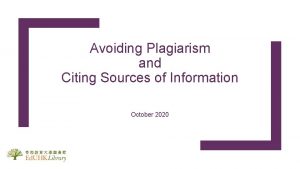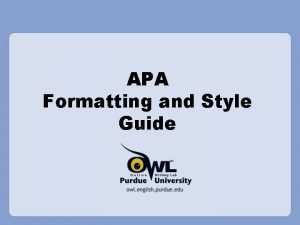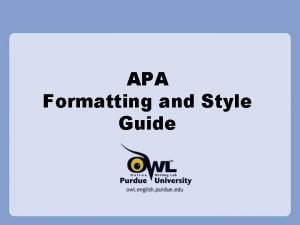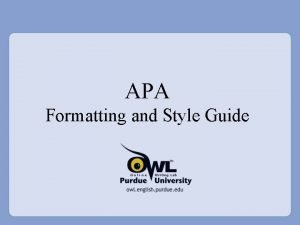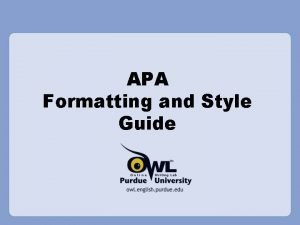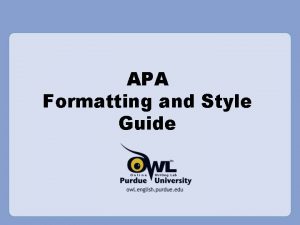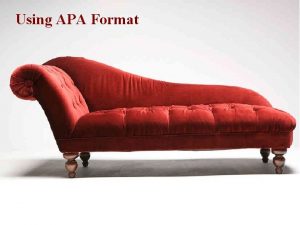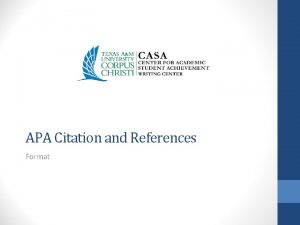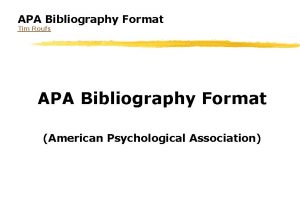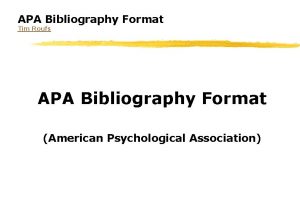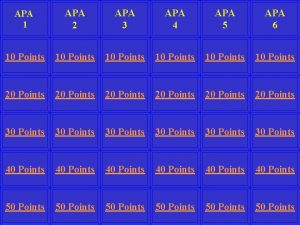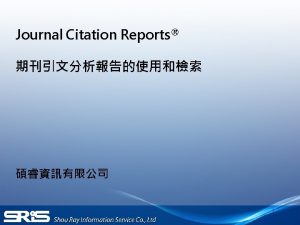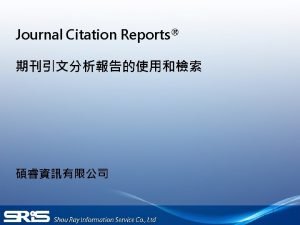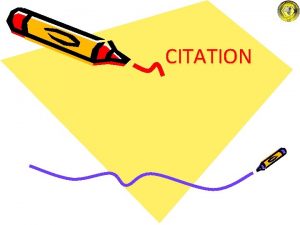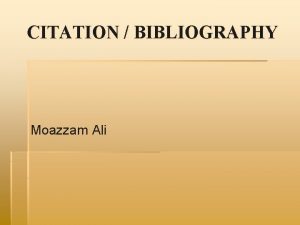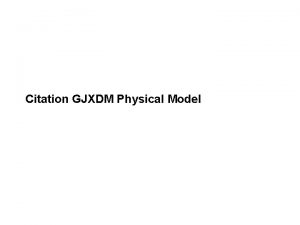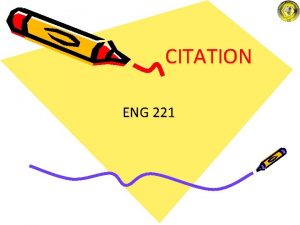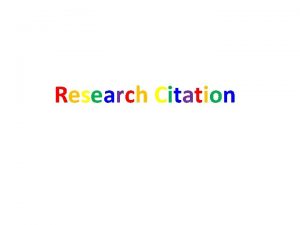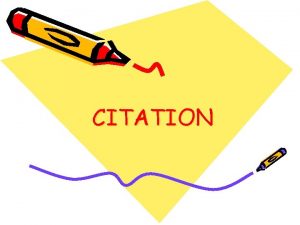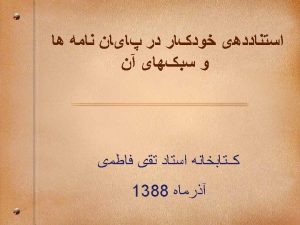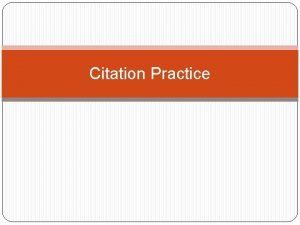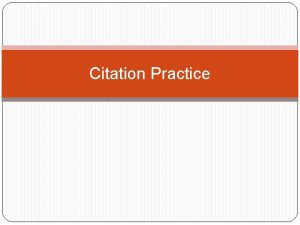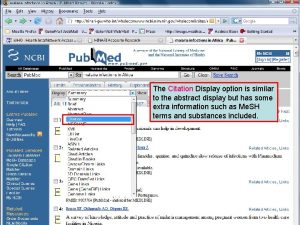APA FORMAT CITATION 6 TH ED 2 ND




















- Slides: 20

APA: FORMAT & CITATION (6 TH ED. 2 ND PRINT) THE WRITER’S RESOURCE LAB (WRL) @ CSU LONG BEACH

THE WRITER’S RESOURCE LAB (WRL): 20+ YEARS OF STUDENT SUCCESS Who are we? We are the only place on campus where you can find experienced and qualified tutors to help you with all of your academic and non-academic writing needs (All writing levels, across all disciplines). WRL tutors are CSULB students interested in helping other students become better writers. Many of our tutors are preparing for careers teaching writing. What do we do? The WRL provides FREE writing instruction for enrolled CSULB students via tutoring, workshops (including GPE workshops), and online resources. How can we help? We can help you learn how to: develop your ideas, develop your writing process and confidence, clarify the purpose and structure of a paper, improve your proofreading and editing skills, and use print or online reference materials. Contact Information (Spring 2017) Hours: M-Th 9 a. m. to 7 p. m. & F 10 a. m. to 1 p. m. LAB 206 (562) 985 – 4329 csulb. edu/wrl Facebook: Writer’s Resource Lab @ The Beach

HISTORY OF APA (AMERICAN PSYCHOLOGY ASSOCIATION) History of Psychology It derives from Philosophy (early Greek Philophers) – both try to answer similar questions but Psychology focuses on methodology. It became its own discipline in Germany & the U. S. during the 1870 s The word “Psychology” was coined by Melanchton (in its Latin form psychologia); it was spread by Rudolf Goclenius APA was founded by G. Stanley Hall in July 1892 in Clark University, Worcester, MA. First to receive Ph. D. in Psychology in U. S. , created first American experimental lab, created first American psychology journal, first to bring psychoanalysis to U. S. , first to promote hiring of woman and minorities, first to recognize the psychological study of children and adolescents, etc. APA is the largest scientific and professional organization of psychologists in the U. S. It includes 54 divisions – interest groups covering different subfields of psychology. The APA has conventions, awards, publications, databases (Psyc. INFO), and its own format and citation style. Controversial decisions on: homosexuality, same-sex marriage, conversion therapy, use of torture, nature vs. nurture, etc. APA Style is used to cite sources and format information within the social sciences. The current APA manual is the 6 th edition, 2 nd printing (as of April 2017).

GENERAL FORMAT *There are 3 types of APA papers, the sections included in your paper will vary depending on the type, professor requirements, and purpose. These are the general format guidelines for all papers. Types of APA Style Papers (3) Experimental Report: Research experiments performed by graduate students and professionals Literature Review: Review (Summary/Analysis/Evaluation) of one or several research papers (one by one or of general topic) Other: Case Study Review, Summary/Reflection, etc. that may be assigned by a professor (they tell you what to include) General Guidelines Typed, double-spaced on standard 8. 5” X 11” paper with 1” margins on all sides 12 point font Times New Roman Page header (running head) at the top of every page on the left ; page number on right Usually written in past tense and using 3 rd person, and limit use of quotes (paraphrasing is highly recommended) Use headings and seriations if appropriate Major Paper Sections (4) Title Page, Abstract/Introduction (background information and with purpose/thesis ), Main body, and Reference page

TITLE PAGE (COVER PAGE) Sections include: Running head, Title, Byline, and Affiliation Running head & Page number (included in header): “Running head” (omit quotation marks) must be flush left, followed by colon, and a shortened version of your title in all caps. Page number should be flush right (page 1 begins in title page). * The words “Running head” are only included on the title page, all pages that follow will only include the shortened title in all caps. Title: Upper and lower case letters centered in the upper half of the page. It should be your complete title and is recommended to be 13 words or less in length (no abbreviations). It may be one or two lines. Double spaced on the title page and trough out the paper. Byline (Author’s Name): First name, middle initial(s), and last name. No titles (e. g. “Dr. ”) or degrees (e. g. “Ph. D. ”) Affiliation (institutional or organizational): May indicate where the author performed the research or are studying. The name must be spelled out.

TITLE PAGE SAMPLE (FROM PURDUE OWL)

ABSTRACT/INTRODUCTION This will be on a separate page. The word “Abstract” or “Introduction” will be centered (no bold, italics, quotations, etc. ). Abstract: Includes information about the research topic, research question(s), participants, methods, results, data analysis, conclusions, implications, and limitations (if applicable). It should be a single, double-spaced paragraph between 150 -250 words. It may include a list of keywords from the paper abstract at the bottom (indent, type “keywords” in italics and without quotations, followed by a colon and a list of keywords separated by commas). The list of keywords are used to help others find your work in a database. Introduction: Includes a brief synopsis of the paper, background of topic while explaining its importance, a thesis/purpose, and other (professor requirements). There may/may not be a limit depending on purpose of paper and professor’s requirements. There isn’t a list of keywords. The rest of the format will be the same as the abstract.

ABSTRACT SAMPLE (FROM PURDUE OWL)

MAIN BODY: LEVEL HEADINGS Level Headings Example

MAIN BODY: SERIATION Seriation is used to present a list of information, it can be done in these ways: Numbered: separated from the paragraph (begin new paragraph, include short description of information, and hen include the bullet list) Bullet point/list: for non-hierarchical and non-chronological order. Separated from the paragraph (begin new paragraph, include short description of information, and then include the bullet list) Using letters within the paragraph Sample On the basis of research conducted by the usability team, OWL staff have completed (a) the OWL site map; (b) integrating graphics with text on the OWL homepage; (c) search boxes on all OWL pages except the orange OWL resources (that is pending; we do have a search page); (d) moving the navigation bar to the left side of pages on all OWL resources except in the orange area (that is pending); (e) piloting the first phase of the three-tiered navigation system, as illustrated in the new Engagement section.

REFERENCES: IN-TEXT (PARENTHETICAL) CITATION BASICS Basics: Follow author-date method (Last name, 4 -digit Year). Use this method if you are summarizing/paraphrasing or when NOT making reference to an entire work. In-text citation capitalization, quotes, and italics/underlining Always capitalize proper nouns (including author names and initials). If you refer to the title of a source within the paper: capitalize all words that are four letters or more within the title of the source. When capitalizing titles: capitalize both words in a hyphenated compound word. Capitalize the first word after a dash or colon. Italicize or underline the title of longer works (books, collections, documentaries, etc. ). Quotation marks around the titles of shorter works (journals articles, articles from collections, television series episodes, etc. ). Short Quotations: When quoting directly from a source, include the author, year of publication, and page number (preceded by “p. ”). Long Quotations: Direct quotes that are 40 words or longer are placed in a free-standing block of typewritten lines without quotations. Start the quote on a new line, indent ½ inch from the left, maintain double-space, and include parenthetical citation after the closing punctuation.

REFERENCES: IN-TEXT CITATION – AUTHOR(S) Two or More Authors: List all last names the first time when citing for the first time, the “et al. ” can be used afterwards (Kernis, Cornell, Sun, Berry, & Harlow, 1993) ; (Kernis et al. , 1993) Six or More Authors: Cite the major author or the first one that appears, then “et al. ” For example, (Harris et al. , 2001) Unknown Authors: Cite source by its title in the signal phrase and in-text citation. Titles of books and reports are italicized or underlined; titles of articles, chapters, and web pages are in quotations. Unknown Date: use author-date style if possible, the organization/website name, or the title in the signal phrase or citation, and THEN “n. d. ” For example, ("Tutoring and APA, " n. d. ). Organization as Author: For organization or government agency, mention the name in the signal phrase and in-text citation the first time it’s used in the paper. Personal Communication: Cite communicator’s name, personal communication, and date. Do NOT include in reference page (E. Robbins, personal communication, January 4, 2001). Citing Indirect Sources: Johnson argued that. . . (as cited in Smith, 2003, p. 102). Electronic Sources: Use author-date style if possible, the organization/website name, or the title in the signal phrase or citation Sources Without Page Numbers: Use paragraph numbers; If there aren’t any page or paragraph numbers, include headings and specify the paragraph under the setting. According to Smith (1997), . . . (Mind over Matter section, para. 6).

REFERENCE PAGE BASICS Hanging indentations: all lines after the first should be indented one inch Last name, first name. If there are more than seven authors, list the first six and then use an ellipses. After the ellipses, list the last author’s name of the work. Entries should be alphabetized by last name Multiple articles by the same author, list the entries in chronological order (earliest to most recent) Present full journal title Maintain punctuation and capitalization that is used by the journal in its title Capitalize all major words in journal titles For books, chapters, articles, or web pages, capitalize ONLY the first letter of the first word of a title and subtitle , the first word after a dash or colon, and proper nouns. Do NOT capitalize the first letter of the second word in a hyphenated word Italicize titles of longer works (books and journals) Do NOT italicize, underline, or use quotations around the titles of shorter works (journal articles or essays in edited collections)

REFERENCE PAGE SAMPLE (FROM PURDUE OWL)

REFERENCE PAGE – ELECTRONIC SOURCES Basic Format Author, A. A. , & Author, B. B. (Date of publication). Title of article. Title of Online Periodical, volume number(issue number if available). Retrieved from http: //www. someaddress. com/full/url/ Scholarly Article with DOI Author, A. A. , & Author, B. B. (Date of publication). Title of article. Title of Journal, volume number, page range. doi: 0000000/000000 or http: //dx. doi. org/10. 0000/0000 No DOI Author, A. A. , & Author, B. B. (Date of publication). Title of article. Title of Journal, volume number. Retrieved from http: //www. journalhomepage. com/full/url/ Article from Database Author, A. A. , & Author, B. B. (Date of publication). Title of article. Title of Journal, volume number, page range. Retrieved from http: //www. someaddress. com/full/url/ Online Lecture Notes and Presentation Slides: When citing lecture notes (PP, word, etc. ), provide file format in brackets after title Hallam, A. Duality in consumer theory [PDF document]. Retrieved from Lecture Notes Online Web site: http: //www. econ. iastate. edu/classes/econ 501/Hallam/index. html

REFERENCE PAGE – ARTICLES IN PERIODICALS Basic form Author, A. A. , Author, B. B. , & Author, C. C. (Year). Title of article. Title of Periodical, volume number(issue number), pages. http: //dx. doi. org/xx. xxx/yyyyy Article in a Magazine Henry, W. A. , III. (1990, April 9). Making the grade in today's schools. Time, 135, 28 -31. Articles in a Newspaper: p. or pp. precede page numbers. Single pages have “p. ” and multiple pages have “pp. ” Schultz, S. (2005, December 28). Calls made to strengthen state energy policies. The Country Today, pp. 1 A, 2 A. Book Review Baumeister, R. F. (1993). Exposing the self-knowledge myth [Review of the book The self-knower: A hero under control, by R. A. Wicklund & M. Eckert]. Contemporary Psychology, 38, 466 -467.

REFERENCE PAGE – BOOKS Basic Form Author, A. A. (Year of publication). Title of work: Capital letter also for subtitle. Location: Publisher. Location: Always list the city and state using two-letter postal abbreviations without periods Calfee, R. C. , & Valencia, R. R. (1991). APA guide to preparing manuscripts for journal publication. Washington, DC: American Psychological Association. Edition (other than the first) Helfer, M. E. , Kempe, R. S. , & Krugman, R. D. (1997). The battered child (5 th ed. ). Chicago, IL: University of Chicago Press. Article or Chapter in an Edited Book Author, A. A. , & Author, B. B. (Year of publication). Title of chapter. In A. A. Editor & B. B. Editor (Eds. ), Title of book (pages of chapter). Location: Publisher. With page numbers: use “pp. ” after the book title and before the page numbers O'Neil, J. M. , & Egan, J. (1992). Men's and women's gender role journeys: A metaphor for healing, transition, and transformation. In B. R. Wainrib (Ed. ), Gender issues across the life cycle (pp. 107 -123). New York, NY: Springer.

OTHER CATEGORIES (PURDUE OWL & APA MANUAL) More References: Other print and non-print sources Poster and power point presentation formatting/sourcing Government Documents Dissertations Report from Private Organization Stylistics: Basics & Avoiding Bias Tables & Figures Abbreviations Statistics Appendix use * The page samples and reference examples have been taken from the Purdue Owl website. The descriptions have been taken from a combination of the APA Manual and Purdue Owl. Not all citations are available through the APA manual or Purdue Owl; if you cannot find a citation, search it online and follow the instructions from a reputable website (. edu, . org, etc. ).

OTHER RESOURCES APA websites: apa. org/pubs/ apastyle. org http: //blog. apastyle. org/apastyle/ APA Manual: Publication Manual of the American Psychological Association (print & e-book) Purdue Owl: https: //owl. english. purdue. edu/owl/resource/560/01/ Classroom poster with APA Basics: https: //owl. english. purdue. edu/owl/resource/560/12/ APA Power point Presentation : https: //owl. english. purdue. edu/owl/resource/560/17/ Print Sources List: https: //owl. english. purdue. edu/owl/resource/560/12/ CSULB’s Library Databases for Psychology: http: //csulb. libguides. com/psyc We have a librarian that specializes in APA & Psychology: Joseph Aubele; the link above will provide his contact information Other – Citing Legal Material in APA (from Westfield State College): http: //lib. westfield. ma. edu/c. php? g=354010&p=2387828 * WARNING: Citations from format generators and databases may not be correct, so review them using the official APA manual or Purdue Owl before submission.

FOR FURTHER ASSISTANCE , CONTACT THE WRL Contact Information (Spring 2017) Hours: M-Th 9 a. m. to 7 p. m. & F 10 a. m. to 1 p. m. LAB 206 (562) 985 – 4329 csulb. edu/wrl Facebook: Writer’s Resource Lab @ The Beach
 How to apa cite a website with no author
How to apa cite a website with no author Apa style in text citation
Apa style in text citation In text citation apa for many authors
In text citation apa for many authors Bibliyograp
Bibliyograp Repeating in text citations apa
Repeating in text citations apa Mla citation format
Mla citation format Chinese name apa citation
Chinese name apa citation How to reference a website apa no author
How to reference a website apa no author Apa citation from website with no author
Apa citation from website with no author Apa simple
Apa simple Rephrasing someone else’s ideas without citation.
Rephrasing someone else’s ideas without citation. Apa in text citation same author multiple times
Apa in text citation same author multiple times Apa same author different year
Apa same author different year How to citation with multiple authors
How to citation with multiple authors In text citation 2 authors
In text citation 2 authors Apa citation with et al
Apa citation with et al Apa in text citation with et al
Apa in text citation with et al Apa citation from website with no author
Apa citation from website with no author In text citation apa
In text citation apa How to in text multiple authors apa
How to in text multiple authors apa Apa in-text citation multiple authors
Apa in-text citation multiple authors
